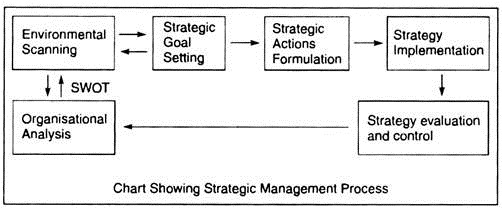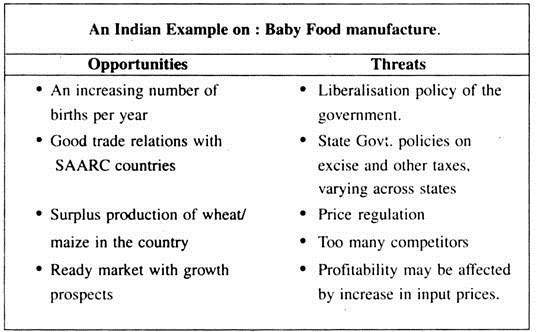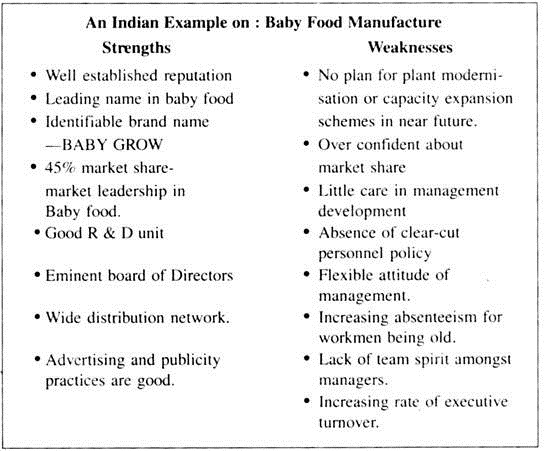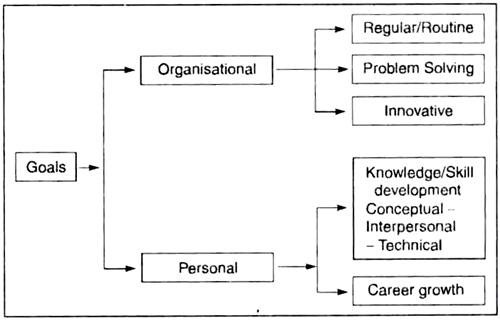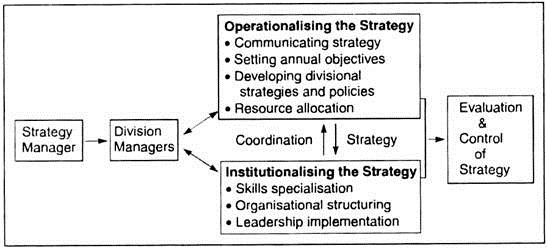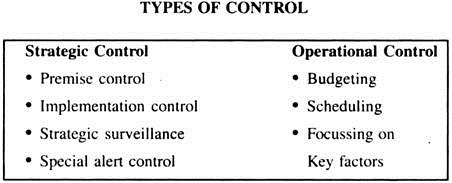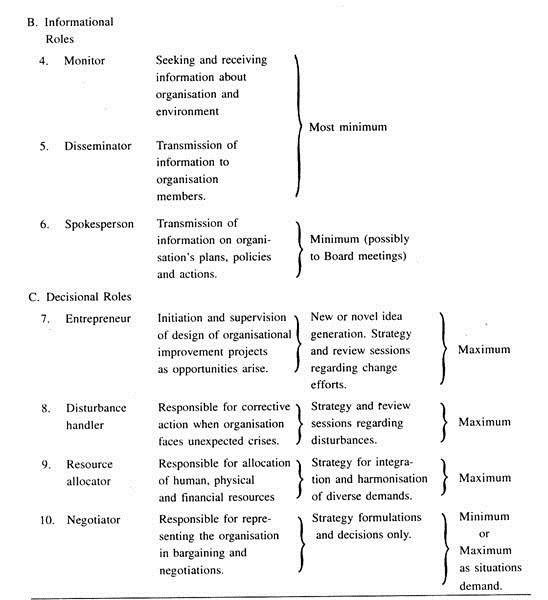Here is a compilation of essays on ‘Strategic Management’ for class 9, 10, 11 and 12. Find paragraphs, long and short essays on ‘Strategic Management’ especially written for school and college students.
Essay on Strategic Management
Essay Contents:
- Essay on the Definition of Strategic Management
- Essay on the Process of Strategic Management
- Essay on the Stages of Strategic Planning Process
- Essay on the Characteristics of Strategic Management Process
- Essay on the Factors and Elements of Strategic Planning Process
- Essay on CEO’s Role in Strategic Management
- Essay on CEO’s Functions in Strategic Management
Essay # 1. Definition of Strategic Management:
The term ‘strategic management’ has been defined differently by different scholars of management.
ADVERTISEMENTS:
Some of them are:
1. Strategic management is “a set of decisions and actions resulting in formulation and implementation of strategies designed to achieve the objectives of an organisation” (Pearce and Richard Robinson).
2. Strategic management is “the manner by which organisations plan to deal with various aspects of management like problem perception, divergent thinking, substantial resources, decision making, innovations and risk-taking” (Cunningham).
3. Strategic management is “the means by which management establishes purpose and pursues the purpose through co-alignment of organisational resources with environment, opportunities, and constraints.” (Bourgeois).
ADVERTISEMENTS:
4. Strategic management can be defined as “the art and science of formulating, implementing and evaluating cross-functional decisions that enable an organisation to achieve its objectives” (Glueck).
Thus
(a) Strategic management is an on-going process of analysis, planning and action. It attempts to keep an organisation aligned with its environment while capitalising on organisational strengths and environmental opportunities and minimising or avoiding organisational weaknesses and external threats, and
(b) Strategic management is also a future-oriented provocative management system. The managers, who use strategic management skills, are seeking a competitive advantage for their organisations and long-term organisational effectiveness.
ADVERTISEMENTS:
It is, therefore, a complex function covering all activities connected with formulating, implementing, recycling and reformulating strategies.
In short, an effective strategic management translates a sound strategy into action. As otherwise, even a sound strategy would be rendered ineffective if it cannot be converted into action.
Hence, it is the duty of the strategic managers to do environmental scanning, assess internal strengths and weaknesses, set goals, mobilise resources, design action plans, implement actions, monitor progress, and control resources and deviations from goals for the achievement of goals and key results areas.
Essay # 2. Process of Strategic Management:
The strategic management process is most often described as a rational and analytical one.
ADVERTISEMENTS:
The process consists of the following activities in different phases:
(i) Environmental Scanning:
Threats and opportunities analysis.
ADVERTISEMENTS:
This involves analysing each threat and opportunity according to its time frame (i.e., short term or long term). Significance and likelihood of occurrence can help focus on the’ most important threats and opportunities.
In identifying them in the organisation’s environment, three questions need to be kept in mind:
(i) Which threats are critical and how can they be avoided in order to derive opportunities?
(ii) Which opportunities are critical and must be exploited?
ADVERTISEMENTS:
(iii) Which threats and opportunities are short-terms and which are long-term?
(ii) Organisational Analysis:
Mission, Strengths and Weaknesses analysis.
ADVERTISEMENTS:
An organisational analysis begins with an analysis of how the organisation is performing and why. A broad statement about purpose, philosophy, and goals would guide executive actions, by the processes of evaluation.
(iii) Strategic Goals Setting:
Understandable, measurable, achievable and challenging long-term goals.
It is necessary to set annual objectives in line with long-term objectives as well as specifying functional strategies consistent with the company’s grand strategy Such goals should be measured in terms of quality, cost, and time-frame.
A chart below classifies and explains the ‘Goals’:
Given the mission and objectives and having done the SWOT analysis, the strategic manager should proceed to generate possible ‘strategy alternatives’. There may be different ‘strategic options’ for accomplishing a particular goal. It is necessary to consider all possible alternatives to make the base for a choice.
ADVERTISEMENTS:
The purpose of considering different ‘strategic options’ is to adopt the most appropriate strategy as ‘goal’. This necessitates the evaluation of the ‘strategy alternatives’ with reference to the criteria like suitability, feasibility and acceptability.
(iv) Strategic Actions Formulations:
An action plan to achieve the goals.
Strategic actions flow from the goals of the organisation. A strategy sets forth a general programme of action and an implied development of employees and resources to obtain goals.
This strategic action can be taken from three approaches:
(a) Functional approach,
ADVERTISEMENTS:
(b) Product approach, and
(c) Business Units grouping approach.
Here, ‘business units grouping’ approach works well in diversified enterprises. All these approaches involve choosing target markets, and product and product development plans, capital expenditure plans, and marketing plans. For all major actions, the aspects of timing and sequencing should be considered.
(v) Strategy Implementation:
Spelling out effective policies or operating procedures to initiate actions for implementing strategy.
This involves translating the strategies into organisational actions. This requires ‘strategic leadership’ i.e., identifying policies, rules, and key results areas; allocating responsibilities; and making operational plans and day-to-day decisions.
Strategy implementation is, thus, the action phase of the strategic management process. This step, therefore, encompasses the operational details to translate the strategy into effective practice.
ADVERTISEMENTS:
A simple chart below sums up the implementation phase:
(vi) Strategy Evaluation and Control:
Monitoring progress of strategic actions and controlling the resources.
ADVERTISEMENTS:
This includes both monitoring progress and control resources—human/physical/ financial—by analysing the deviations from standards and goals and providing the feedback for modifications.
It is important to note that traditional control parameters are not adequate here as they delay the results and thereby become a useless exercise to face the environmental risks and uncertainties. In contrast to ‘past-action control’, strategic control is forward looking and attempts to steer the company on a long-term basis.
Essay # 3. Stages of Strategic Planning Process:
Stage 1. Defining the mission.
Stage 2. Assessing organisational Resources.
ADVERTISEMENTS:
Stage 3. Evaluating Environmental risks and opportunities.
Stage 4. Establishing long-term Objectives.
Stage 5. Formulating strategy.
Stage 6. Establishing Annual Objectives.
Stage 7. Establishing Operational Plans.
Stage 8. Implementing the Plans.
Stage 9. Implementing, Monitoring and Adapting.
These stages seldom occur in a fixed sequence, and some may take place simultaneously, but given the flexibility needed for a bit of cycling— revising, seeking authorisations and coordinating—some rationale exists for considering the stages in the order presented (Williams, Du Brin & Sisk, 1985).
Strategies are designed by top management of an enterprise. They come to be as a result of the strategic planning process.
Essay # 4. Characteristics of Strategic Management Process:
The basic characteristics of the strategic planning process may be as follows:
1. It is the place where decisions of highest importance to a company are made. Here is where the basic thrust and direction of the company is determined and the major approaches are decided.
2. The time spectrum covered ranges from the very short range to infinity. Although the general thrust is long-range, a decision can be made in this process to stop producing Product X tomorrow or start to build tomorrow a new plant to produce the Product Y.
3. The process may produce a written document on a periodic basis, say annually—yet the process is a continuous activity. Top management cannot, of course, develop a strategic plan once a year and forget strategy in the meantime.
4. Compared with medium-range and short-range planning, the results of strategic planning process are not usually neatly incorporated into a prescribed form.
5. Strategic planning covers any element of the business that is important at the time of analysis and embodies details that are of sufficient scope and depth to provide the necessary basis for implementation.
6. The format of strategic plans is much more flexible and variable in content, from time to time, than for other types of plans.
7. Strategic planning process has many starting points, each different from the other.
8. Strategic planning is especially appropriate in volatile industries, such as the computer or telecommunication or anti-pollution industries where technological change is rapid and international competition is fierce.
9. Strategic planning is uniquely suited for providing ‘a broad managerial perspective which rescues management from the tunnel vision of unanalysed assumptions and fuzzy objectives’.
10. Strategic planning, even if the methods as well as the human resources and other situational variables differ greatly from one firm to another, is an increasingly necessary aspect of effective management.
Essay # 5. Factors and Elements of Strategic Planning Process:
From the above, we see that the general contents of strategic planning process are:
(i) Objective of enterprise,
(ii) Basic mission,.
(iii) Basic strategies, and
(iv) Operational plans.
The factors and main elements of strategic planning process can be best identified and shown in a model below:
As we can see, strategic planning involves the development of objectives (step 1 in the planning process). Next the top management searches for the environment.
Next top management weighs the advantages of the several strategies considered and chooses one. It outlines the general organisational and policy changes necessitated by its strategic choice. It then delegates detailed planning and implementation activities to its middle management. Top management also sets budget levels and indicates general usage of funds; detailed budgeting is done by middle management.
Strategic planning is exciting. It involves decisions like: Xerox Corporation’s decision to enter (and leave) the computer field, Reliance Industries’ decision to get out of textiles and become a conglomerate, or Cadbury chocolate’s decision to become Cadbury Foods (all hypothetical).
Essay # 6. CEO’s Role in Strategic Management:
The increasing time demands of strategic management have nowadays forced top managements among the larger companies to delegate more and more of the operating authority for running the business to lower-level managers.
Some companies today have Chief Executive Officers (CEOs) who are concerned essentially with outside environmental forces, and Chief Operating Officers (COOs) who are concerned primarily with running the day-to-day affairs of the business. In these cases as well as in others where there is no COO or its equivalent, more authority is usually being delegated to middle managers.
This does not mean that top managements remain unconcerned about the day-to-day operational matters. Only thing is that, in the changing environment from that of the past, the top managements are forced to spend much less time on routine operating matters and to devote much more time on strategic issues.
The most important case in point is that managerial strategies in large-sized organisations are considerably different from the operational strategies needed. After all, corporate level strategy in the changing environment is essential for success and growth, and for competitive advantage. Herein, comes the role of the chief strategist, the CEO.
The chief strategist is faced with three basic questions:
(1) What business are we in?
(2) How are we to match the best product-market opportunities?
(3) How are we to make best use of the company resources?
The first two questions are concerned with corporate-level strategies, while the third question relates to operational-level strategy. The CEO must conceptualise the whole strata of strategy as he is at the top. CEO is responsible for relating his organisation to a changing environment.
He alone is responsible for assuring the proper balance among various competing subsystems in the organisation. He alone is responsible for determining the total thrust of his organisation and for assuring that performance matches with his design. So, the role of the CEO is unique and so is his way of thinking.
Again, the CEO is expected to concentrate on the total enterprise rather than parts of it, and in the process ‘entirely new phenomena take place’.
CEO has to think in these terms. The thought processes, the attitudes, the perspective, the methods of analysis and the skills in the total strategic management process are unique and of demanding nature and call for higher level dynamism and initiative. CEO, as the chief strategist, has to have widest vision in these respects.
Essay # 7. CEO’s Functions in Strategic Management:
Mintzberg’s classification of ‘Ten Managerial Work Roles’ vis-a-vis the functions/roles that concern the chief strategist is given below for better comprehension:
From the above, we find that ‘Decisional Roles’ and ‘Functions’ fit well with the CEO as the Chief Strategist.
In looking at the entirety of an organisation, the CEO also approaches decision making differently than major division line managers. For example, the divisional manager may ask for a capital allocation to meet the needs that the CEO may not grant because of other higher-level priorities of the total organisation.
The CEO also thinks differently than functional managers. For example, the sales managers desire to place greatest emphasis on increasing sales, market share, and customer reputation—may be at the expense of profits.
The financial managers tend to think in terms of profit, liquidity, low risk, and high ROI. This viewpoint, if not balanced and harmonised, may stifle growth and reduce risk-taking and initiative. Other functional managers may have different driving motivations. All must be related to and integrated in the larger organisation of which they are a part, and that is done by the CEO.
To illustrate a case in point in relation to strategic planning process, let us consider the CEO’s job descriptive role, as someone has put it, “The CEO is the chief architect of the firm’s future and the chief planner.”
In this role, the CEO has several fundamental responsibilities as to the functions like:
1. Making sure that the climate in the firm is congenial to doing effective planning;
2. Ensuring that the system is organised in a fashion appropriate to the company;
3. If a corporate planner is engaged, seeing to it that he is the right person for the job;
4. Getting involved in doing the planning; and
5. Having face-to-face meetings with those who draw up plans for the CEO’s review and approval.
In essence, the CEO has to play different roles and carry out different functions from the phases of strategic directions to strategic guidelines and implementations and control in complex organisations as compared with very simple ones.
